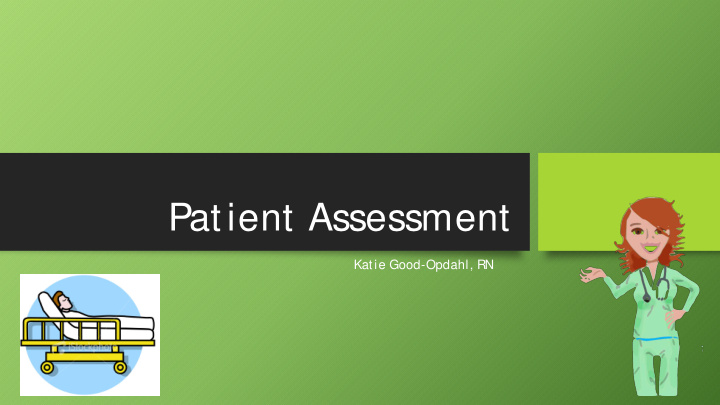



Patient Assessment Katie Good-Opdahl, RN
Obj ect ives • Following t he present at ion, individuals should be able t o: • Complet e a t horough head t o t oe assessment of t he ED pat ient • Wit hhold knowledge for early recognit ion of t he crit ical ED pat ient
“ The compet ent emergency nurse must be a ‘ j ack-of-all-t rades’ , mast er of most ” • Pat ient s present t o t he ED wit h every possible medical, surgical, t raumat ic, social and behavioral healt h condit ion. • S ubj ect ive vs Obj ect ive Dat a
Back t o t he Basics • Gown every pat ient , every t ime • A-I mnemonic for assessment • Primary vs S econdary Assessment s • Bot h can be complet ed wit hin minut es unless resuscit at ive measures are required.
Primary Assessment • Ut ilized t o ident ify and address pot ent ially life-t hreat ening condit ions • ABCDE • Airway • Breat hing • Circulat ion • Disabilit y • Exposure
Secondary Assessment • Ident ify all clinical indicat ors of illness or inj ury • FGHI mnemonic • Full set of vit als • Give comfort measures • Hist ory and head-t o-t oe assessment • Inspect post erior surfaces
Airway Assessment Act ions include: *Ident ifying and removing any part ial or complet e airway obst ruct ion; *Posit ion airway t o maint ain pat ency Int ervent ions: *Insert oropharyngeal or nasopharyngeal airway *Prot ect cervical spine
Breat hing • Assessment Act ions include: • Assist breat hing wit h oxygen t herapy, mout h t o mask vent ilat ions, or bag- mask vent ilat ion as needed • Int ubat e when necessary • Int ervent ions: • Assist in providing vent ilat ions and supplement al oxygen as needed • Relieve t ension pneumot horaces may be necessary t o support breat hing effort s
Circulat ion • Assessment Act ions include: • Evaluat e pulse presence and qualit y, charact er, and equalit y • Assess capillary refill, skin color and t emperat ure • Assess for diaphoresis and skin t urgor • Int ervent ions: • If no palpable pulse is present , init iat e CPR and resuscit at ion effort s
Disabilit y • Assessment Act ions include: • Det ermine level of consciousness • Int ervent ions: • If alt ered level of consciousness, furt her assessment needs t o be complet ed in order t o invest igat e cause.
Exposure and Environment al Cont rol *All pat ient ’s should be in a gown -Provide a blanket -Trauma pat ient ’s meet requirement s t o have warmed rooms
Secondary Assessment – Full Set of Vit als • Temperat ure • *Weight, Height, and head Core t emperat ure recommended circumference • Rect al • Urinary cat het er t hermist ors • Pulse • Palpat e cent ral pulses • A change is indicat ory of compensat ory mechanisms • Respirat ions • Count respirat ions for a full minut e • Chest must raise equally on bot h sides • Oxygen Sat urat ion • Good plet h • Observe wit h clinical appearance • Blood Pressure • Proper cuff size • Cardiac monit or vs manual BP
Give Comfort Measures • Pain is referred t o as t he 5 t h VS • Age-appropriat e st andardized t ool • F ACES Pain Rat ing S cale • FLACC – face, legs, act ivit y, cry and consolabilit y • Comfort measures init iat ed based on chief complaint and obvious inj ury
Hist ory • AMPLE • Allergies • Medicat ions • Past healt h hist ory • Last meal eat en • Event s leading t o t he illness/ inj ury
Head-t o-Toe Assessment • Head and Face • Neck • Chest • Abdomen • Pelvis/ Perineum • Ext remit ies • Post erior S urfaces
Recommend
More recommend